A moving, haunting, and cathartic look at Roger Ebert's passing by his lovely wife Chaz.
Electric Shadow
The Missing Disc: BEYOND THE VALLEY OF THE DOLLS with Ebert Commentary
This movie is readily available on DVD, but the now-OOP Special Edition carries an indispensible Roger Ebert commentary that is missing from the in-print version. I don't know why this commentary disappeared when the movie was re-issued, but I presume it may have had something to do with licensing terms with the Ebert company. It could have just been Fox Legal not wanting to do some additional paperwork, I don't know.
Knowing it isn't there makes the movie un-purchaseable for me. I bought the "old" version from a local secondhand DVD shop with money that could have gone toward a reasonably-priced new copy.
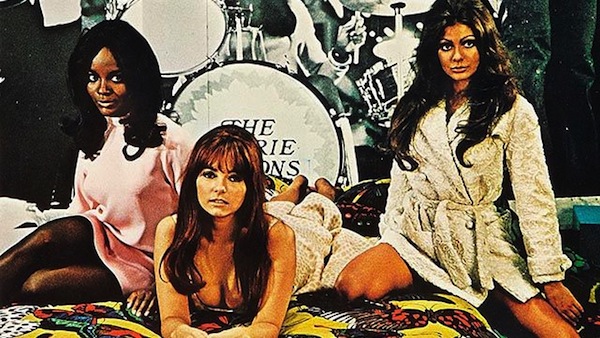
The Missing Disc looks at movies that are either not available on disc at all, or which exist only in A/V quality and packaging that film fans and scholars find lacking. Every movie should be on Blu-ray, but life isn't fair, and there isn't necessarily enough restoration and remastering money around. This column fights the most reasonable fights possible.
Four Minutes of Ebert on Ozu
Criterion posted the first four minutes of Roger Ebert's commentary on their Floating Weeds DVD at the beginning of April, which I only noticed when they put a link to this post at the top of their most recent newsletter.
Daily Grab 120: A Month Hasn't Gone By
One of Roger Ebert's favorite parts of Citizen Kane is this scene with Mr. Bernstein, according to a joint interview he did with Gene Siskel in 1996. The short monologue that is so memorable to so many:
"A fellow will remember a lot of things you wouldn't think he'd remember. You take me. One day, back in 1896, I was crossing over to Jersey on the ferry, and as we pulled out, there was another ferry pulling in, and on it there was a girl waiting to get off. A white dress she had on. She was carrying a white parasol. I only saw her for one second. She didn't see me at all, but I'll bet a month hasn't gone by since that I haven't thought of that girl."

The New, Beautiful RogerEbert.com Leaks
I've seen this non-private but hidden link tweeted all over creation this morning (UPDATE: glad I got in before it got password-protected. see followup below). This is the cleanest, best-designed film review site on the web. Crisp, uncluttered, and just gorgeous. Wow.
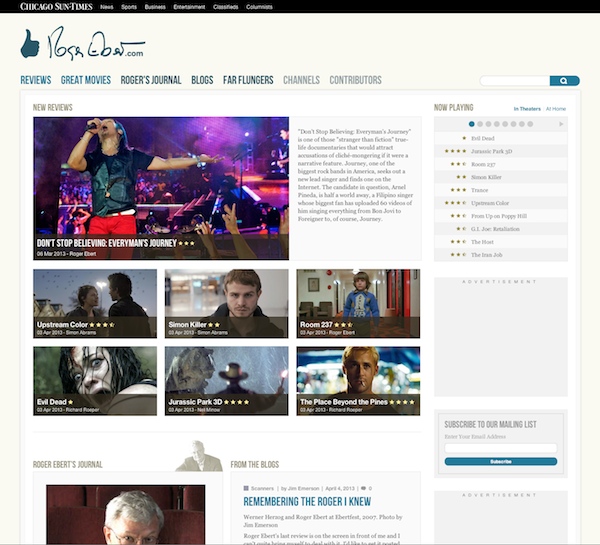
Now that it's hidden behind a password wall, here's a screengrab of the From Up On Poppy Hill review. It launches officially in just a couple of days, so there's not long yet to wait. Further down, a look at what happens when you mouse over the link categories.
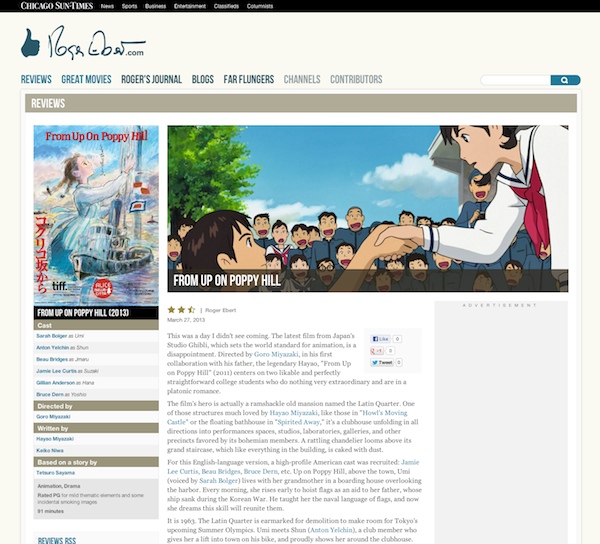





Daily Grab 119: Are They Standing for Me?
Charles Foster Kane (Orson Welles), in Citizen Kane:
"Are they standing for me?"
"Ask them to sit down, will you please?"
This sentiment, expressed by the better man C.F. Kane was in his youth, sums up everything I've heard about the man-of-the-people nobility of Roger Ebert, in work and life otherwise.
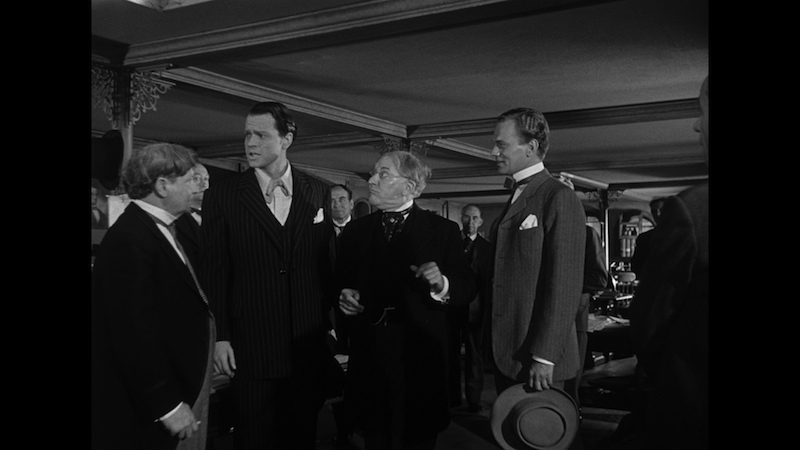
Ebert: Remembrances of Presence
I've seen some rather questionable hitwhoring posts, like a gallery/clickpost at Huffington Post that covers Ebert's favorite movies of every year, and some aggregate linkposts that point to every obituary some intern found thanks to a Google Alert. Thankfully, that sort of junk is the extreme minority of what I've read.
Rather than get salty and nasty about all of that, I thought it more in keeping with what friends who knew Roger personally would say his impulse would be: ignore the morose and negative and focus on the positive. That's what I tried to do in what I wrote yesterday.
I've collected links to articles I've read about Roger that were written over the last couple of days. I picked ones that moved me and that I think you should read. Each link is accompanied by a short selection, all of which celebrate the good work and good practices that Ebert encouraged and nurtured in multiple generations of writers.
The thumbs were a marketing tool. A lamentable one? I'm not one to say, especially as I get older. We are either of the world or opposed to it. Having opted to be of the world, they played by its rules, but also gave them some pushback. Roger was giving pushback to the right people until the end.
How could one not admire that? So of course I did. But as a critic, the thing I had the most admiration of Roger for was something I sometimes flatter myself to think of as an affinity with him: his unflagging openness, aesthetic and otherwise. As I wrote in the obit, Ebert "understood genres but didn't truck in genre hierarchies." He could enjoy what some critics refer to as "trash" without making a big production out of making sure everyone reading understood he was the kind of critic who could "enjoy trash," if you follow me. And he was always a cheerleader for maintained intellectual curiosity.
Matt Zoller Seitz manages a great deal in just his opening graph:
No one was better at describing the emotional experience of watching a film than Roger Ebert. Few were better at describing the emotional experience of life. Roger knew the two experiences were one and the same. That was his genius.
Roger lived to introduce us to new films, new faces, new ways of thinking and seeing. When he got excited – as he did about Spike Lee, Steve James, Zhang Yimou, Jane Campion, Jim Jarmusch, Steven Soderbergh and all the other filmmakers he helped put on the map – his words had an evangelical fervor; when he turned melancholy or introspective, they had a Talmudic wisdom. At its most impassioned, Roger’s writing (and his spirited declarations on the old TV shows) reminded me of my favorite admonition from Corinthians, that “in the assembly” -- i.e. the church -- “I would rather speak five words with my understanding, that I might instruct others also, than ten thousand words in another language.” Roger spoke for the assembly, in simple but eloquent language. He described films, filmmakers and even whole film movements in punchy sentences and colloquial phrases and controlled bursts of lyricism that stimulated discussion rather than shutting it down. “Without ever once deviating from a conversational tone, Ebert could make watching Welles, Bresson, Ozu and Mizoguchi sound like nothing less than the purest joy,” wrote Variety’s Justin Chang.
Ignatiy Vishnevetsky, in a piece written as a letter to Roger that contains the kind of honesty and openness that Ebert so treasured:
I was married in the basement of the county courthouse 11 days later. The judge was about to take her lunch break, and the ceremony was conducted in a hurry. The next day, we began rehearsals for Ebert Presents: At the Movies. The first day of taping, I couldn’t stop playing with my wedding ring, which felt foreign on my hand. I’d never worn a ring before; I could always feel its weight, its presence. Now, on the rare occasions when I take it off, my hand feels naked, too light.
In e-mails, you were enthusiastic about the future. You and Chaz were taking control of your website—the first step in an ambitious digital expansion. You were carefully managing every aspect. You sent me an e-mail with detailed instructions about formatting for review aggregators—business stuff. You ended it with: “Ignatiy, someday your newborn will click on that link.”
Roger's right-hand man Jim Emerson on the internal conflict over the editing of Roger's final review, for Malick's To the Wonder:
Roger Ebert's last review is on the screen in front of me and I can't quite bring myself to deal with it. I'd like to get it posted right away because I know that's what Roger would want under the circumstances. ("We'll be getting a lot of traffic!") Actually, he filed two or three other reviews before his condition took a sudden turn for the worse. But this final one -- sent March 16 and labeled "FOR USE as needed," is of Terence Malick's "To the Wonder," which (spoiler warning) he liked quite a lot. Publicists might object that it hasn't opened in Chicago yet, but Roger wasn'tjust a Chicago movie critic (though he certainly was that). I can imagine his email now: "Who's going to complain? It's three and a half stars!"
My friend and mentor (whether he approves of the title or not) Drew McWeeny on his "weekend in Chapaign-Urbana":
Then in March of 2002, Roger wrote and asked me if I would like to join him in Champaign-Urbana, his hometown, to be a guest at his Overlooked Film Festival. He wanted to do a double-feature of Fritz Lang's original silent masterpiece "Metropolis" and the Rin Taro anime film "Metropolis," and he wanted me to join him for a conversation about anime onstage afterwards.
I have never said yes to an invitation faster than I did that day.
There was an opening night party, so as soon as I was dressed, I headed back out to the party, where I got to meet Roger. The party ran late, and at the end of it, Roger told me that he'd be happy to take me home.
What followed was a two hour drive around Champaign-Urbana, just the two of us in the car, as he told me stories about his childhood and his time in college and as we discussed film and life and everything else. It was surreal, but it also served as the last step in me seeing Roger as not just an icon, not just one of my heroes, but as a friend, as an exceedingly decent person who had built a life for himself that I admired greatly.
I've read that one four times.
Dana Stevens at Slate wrote to Roger as a pre-teen:
I’m not sure how old I was when I wrote Roger Ebert a letter asking for his advice on how to become a film critic, but judging from the other documents in the manila envelope where I’ve kept his response ever since, I must have been somewhere between 11 and 13. Ebert’s prompt and kind answer, typed on Chicago Sun-Times stationery using a typewriter with a wonky T key, took my query more seriously than it deserved, suggesting colleges with strong film programs I might consider, advising me to “see all the good movies you can,” and most of all encouraging me to “write-write-write for anyplace that will print your stuff.”
Richard Roeper, who rightly declares that a Mount Rushmore for film critics would start with Roger Ebert:
Roger would have told me to stop fretting and start writing.
He was corny. For years, Roger and Chaz would host massive Fourth of July parties at his home in Michigan, and Roger would always wear his wonderfully tacky American flag shirt while presiding over the karaoke contest and the barbecue and the dancing on the temporary floor installed in the backyard. You never saw him happier than when he was surrounded by family and friends.
He was kind. As a television partner, Roger was exceedingly generous. Even though he was risking the wrath of Disney for spilling the news too soon, Roger told me I had the job before Disney told me I had the job. When the news was made official, Roger took me aside and said, “This is a partnership. You’re not a guest on the Roger Ebert show. You’re my co-host. It’s a 50-50 deal.”
And so it was. We had equal time on “Ebert & Roeper.” The second time we appeared on “The Tonight Show,” Roger insisted it was my turn to take the lead and sit in the chair next to Jay, with Roger on the sofa.
Former editor Steven S. Duke on Ebert's everyman, salaryman demeanor:
He also was — for those who remember him from television in that cushy theater with Gene Siskel or Richard Roeper — in person exactly the man that you see or read about. He was warm, gracious, embracing, funny, generous. There was nothing false about him. He was also, despite the bulk of his income coming from television at the point that I was working with him — he called himself a newspaperman. That was his identity. He never viewed himself as a star, never viewed himself as a television performer. He was very much a proletarian newspaperman and a proud member of the working press fraternity.
Matt Singer's opening to a piece in which (among other things) he recounts the multiple book signing encounters he had with Roger:
Back when MySpace was a thing, you had to fill your profile with all these tidbits of information: favorite movies, books, television shows and so on. There was also a spot at the bottom to list your heroes. On my page -- which still exists, if you want to fact check me on this -- I wrote two names: Roger Ebert and Spider-Man.
Once he was no longer able to speak, he turned his blog into an outpouring of musings on every topic imaginable, from alcoholism to atheism. In some ways, I actually enjoyed his writings on subjects outside of film even more. They reflected a curiosity, a yearning to be a citizen of the world rather than just a big fish in a particular pond.
Justin Chang, on Ebert's engagement with his readers and those who disagreed with him:
To my surprise, Ebert saw fit not only to publish my letter in his Movie Answer Man column, but also to write me a personal reply, in which he thanked me for getting in touch, conceded some of my points while gently reasserting his own, and told me he respected my work. Shamed but not silenced, I sent back a bloated apology, which occasioned another polite response and an altogether friendlier, more harmonious back-and-forth. I may have started us off on the wrong foot, but Roger redeemed our encounter with his characteristic good nature and genuine delight in engaging with his readers — the very qualities that made him, for so many of us, an ideal companion at the movies.
My takeaway lesson was that an act of grace, especially one coming from an elder and a superior, will always prevail over a difference of opinion. And it was the consummate grace of Ebert’s voice — that inimitable blend of wit, erudition, amiability and common sense — that made him our most important and indispensable film critic, someone you loved to read no matter how violently you disagreed with him. Like all great thinkers and writers, he rendered irrelevant the small-minded tyranny of right and wrong answers through his vivid, literate and unpretentious command of language. His thumbs may have changed the face of criticism, but it is Ebert’s writing for which he will be most fondly and significantly remembered.
Now a pile of my pals at Ain't It Cool.
Eric Vespe:
I personally only met the man once. It was at Sundance and I sat in a group with him watching the awful, horrible, agonizing fuck you of a movie TWELVE, directed by Joel Schumacher. Before the film he was engaged in a conversation with my pal Katey Rich of Cinemablend. He had his surgery at that time, so he didn’t have the ability to speak, but he wouldn’t let that stop him from communicating.
The conversation consisted of Ebert asking Katey questions by writing them on a piece of paper and handing it over, then taking part in the conversation that would begin there with more paper notes, head nods and hand gestures.
After the film I made a point to shake his hand and tell him how much his work with Gene Siskel meant to me growing up. He looked down at my badge (which read ERIC VESPE – Ain’t It Cool News), picked it up off my chest, pointed to it and gave me his incredibly famous thumbs up.
Without a single word, only a gladiatorial gesture, he made me smile for a solid 24 hours. I imagine that’s how he made thousands of filmmakers, old and young alike, feel in his long career as a critic.
Steve Prokopy:
I've told this story before, right after it happened in 2002. I was lucky enough to attend one of the Ebert & Roeper Film Festival at Sea events, and during one of the Q&As, one question that came up had to do with the internet’s influence on movies and movie marketing. Roger answered that the influence was two-fold: one, that audiences in general know more about a film before its release. Everything from casting news, effects previews, trailers, to fights on the sets are chronicled on various movie-related sites on the internet. Second, a whole crop of "young, talented critics" has arisen, many of whom have a larger reading audience than most print critics. They have a different agenda for liking or disliking a film, and are not shy or polite about expressing their opinions. He continued:
Ebert: In fact, there’s someone here from Ain’t It Cool News who writes under the name Capone. Where are you? [I tentatively raised my hand.] Stand up for a second. [I did as told.]
Richard Roeper: They write under assumed names at that site, but there’s what he looks like!
Ebert: And he’s a good example of one of these up-and-coming critics whom the movie studios dislike, but are becoming more and more a part of the process and the mainstream. His reviews are funny but still manage to make their point as well, if not better than, any "legitimate" film critic.
And in that single moment, I went from wanted to be a film critic to wanted to be one for the rest of my life. You see, Roger didn't see film criticism as a competition; even his rivalry with Gene Siskel was more about working for competing newspaper than any dislike he had for the man. He supported the critics and other writers he loved with as much passion as he did his own work. He would tout them because they were furthering the cause of putting eyes on movies that we all loved, and that should always be the goal.
Alan Cerny:
Ebert taught me I wasn’t alone. Through his words and writing, his passion fed my own. I swore that if I wasn’t going to make movies, then by God I’d be writing about them. It’s been a drive that’s stayed with me my entire life, and good or bad I’ve tried to live up to that drive every day. Some days I fail miserably, and then I look at Roger Ebert, who even when losing his voice and his health had a fire for cinema that I wanted so badly to sustain in myself. I remember when DO THE RIGHT THING came out, and all (or most) of America railed about its supposed violence and its inciting of the races. But Roger Ebert knew the score. He knew that it was a masterpiece, and the way he and Siskel championed that film in those turbulent times still shows me that, goddammit, film advocacy MEANS SOMETHING. Film reflects our lives, and Ebert helped show us all that criticism can be a fervent, revolutionary act as much as picking up a gun and storming a bulkhead could be. The power of his words, even when I disagreed with him, always filled me with that zeal.
Jeremy Smith:
As I got older, I began to seek out their writing, and soon found myself relating to Ebert's way of reviewing a movie - and, man, was he relatable. When Ebert loved a film (and he was quick to love, which speaks to what a quality human being he was), it was an exhilarating explosion of emotional and intellectual ardor. Before he began revisiting films as part of his essential "The Great Movies" column, I'd read and re-read his appreciations of THE GODFATHER, STAR WARS (he was onboard from day one) and E.T. Of course, it was always an event when he wrote about Martin Scorsese, who was a fellow guilt-ridden Roman Catholic. But I especially loved it when he sparked to an unappreciated artist's work. He was an early admirer of Jennifer Jason Leigh, praising her work in FAST TIMES AT RIDGEMONT HIGH while most rushed to condemn the film wholesale (Ebert didn't like it either, but he responded to the performances). Ebert was also a vociferous defender of Spike Lee's from the beginning, going on to write several definitive pieces on DO THE RIGHT THING. That's what was so great about Ebert: when a film got to him, he couldn't stop writing about it. And when a similarly-themed film let him down, he'd sometimes use the column space to champion the better movie.
All those are collected in a big mega-length piece linked above as well as here.
The best bit from Harry Knowles' standalone piece:
I most loved their advocacy episodes where they took and highlighted a career, or films they wanted to be included in the Academy’s OSCARS. Read Roger’s writing, it is something beautiful. It can enrage and inspire. And every single word, he believed. In those reviews he teaches you about life, art and the thoughts he had about it all. Roger Ebert had a beautiful life and he lived it spectacularly.
To be the sort of person that always gives a leg up, to encourage, instead of discouraging. Roger was an enthusiastic advocate for that which I love so dear, FILM. To watch it, to make it, to write about it, to exhibit it and to celebrate it. He was what was best about those of us that choose to spend our lives in a darkened theater with our fellow weirdos and tell the world about the dreams we saw projected there.
Todd McCarthy, on his and Ebert's campaign for more art houses:
One early article Roger wrote had to do with the dire shortage of art house cinemas in our fine city. As a high school student, I was just developing a hunger for foreign films, and a lot of great ones were coming out in those days. We'd read about them when they opened in New York, but precious few would make it to Chicago, principally because there were only two, perhaps three, theaters on the North Side that would show them and they were typically booked for months at a time showing hits such as A Man and a Woman, King of Hearts and The Shop on Main Street. As a result of this logjam, many important foreign films would never make it to Chicago at all.
Inspired by Roger's sensitivity to this situation, I wrote a letter commending his attention to it and, as I recall, enumerating all the films I could think of that were caught in the backlog. He ran it right away, which resulted in my writing another letter about something else, and then another, culminating in his invitation to join him one day down at the popular journalists' watering hole, O'Rourke's. I was too young to join Roger in downing a few, but we nonetheless discussed everything from the brilliance ofRaoul Coutard's cinematography to our desperate hunger to see Orson Welles' Falstaff (Chimes at Midnight), which we eventually saw on opening night when this great but blighted film had its belated Chicago debut at a former burlesque house (home of stripper Babette Bardot) that had been converted to a highbrow haven -- inspired, in our minds, by our campaign for more art houses. (It didn't last long.)
As I would later learn, this encounter was exceptional for me but nothing unusual for Roger, who always took a keen interest in the next generation, and who managed — even in a time before email — to maintain a voluminous ongoing correspondence with fans, detractors, colleagues and humble advice-seekers. He was a true man of the people in a profession often accused of smug elitism.
I've returned to Andy Ihnatko's brief but deeply moving piece more than any other:
I’ve lost one of my favorite writers of all time. I’ve lost one of my most trusted, respected, and generous advisors on all subjects that could possibly matter to a modern human being. And I’ve lost a great friend of more than 20 years.
But I still have him in the form of the finest and highest standard of what it means to be a journalist and critic. All my life, Roger Ebert has always been the bar I’ve tried to reach. I never will. But his example has made me stronger through failure.
Paul Dini on Siskel & Ebert's Review of "Batman: Mask of the Phantasm"
This is the 20th anniversary year for this landmark animated movie, which was originally supposed to go direct-to-video. It ended up getting rushed into a lousy theatrical release. From Paul Dini's post on Facebook:
A year after BATMAN: MASK OF THE PHANTASM opened on the kiddie matinee bill to poor box office and little critical notice, I was pleasantly astonished to turn on AT THE MOVIES one weekend and watch Roger and Gene deliver a rave review of the picture. PHANTASM was so poorly distributed they had missed it in theatres (Roger would later tell me he thought it was a Bugs Bunny-like compilation of TV episodes with bits of new linking footage) and they never watched it until they had received a review copy on tape ten months later. They praised the noirish look of the feature, the writing, and the voices, and apologized for letting it slip under the radar the year before. A few months later Alan Burnett and I met Roger at a Sundance screening, and we had a chance to talk before the show and thank him for the nice review. He had many nice things to say about the show, which led into a long conversation about movies in general. It was a very nice night, and even though we never met face to face again, we swapped e-mails now and then. Roger was a good guy, a gifted writer, and as he proved over the last few years, a tremendously courageous soul.
A transcription of a portion of Roger Ebert's comments:
"I think that the day is coming, and it's also happening with the Disney pictures, when adults are realizing that animation is not limited to an entertainment form for children...and that animation can do some things that live action can't do.
"For example, the sets for the city in this movie are seen more clearly than they are in the live action movie, where they're kind of murky. The exaggeration of the effects and the camera angles can be stretched and played with in a way that isn't available in the real world. And then also here, it's really interesting that they actually have a story, more of a story than the movies. They have characters, and they think, and they pause, and motivations, and you get involved in it."
The review itself (which like many "rogue" S&E postings, could disappear):
Shamewatch: OOP "Beyond the Valley of the Dolls" with Ebert Skyrockets Overnight
Yesterday I thought "I should probably grab one of these used copies for around ~$12 before they disappear". This out of print edition of Beyond the Valley of the Dolls is the only way to hear Roger Ebert's commentary track for the movie.
The real danger was that they would surge to insane prices. The least expensive used copy on Amazon is now $50. I wish there were a feature on Amazon that allowed you to report price gouging abuse and block yourself from unintentionally buying from sellers in the future.
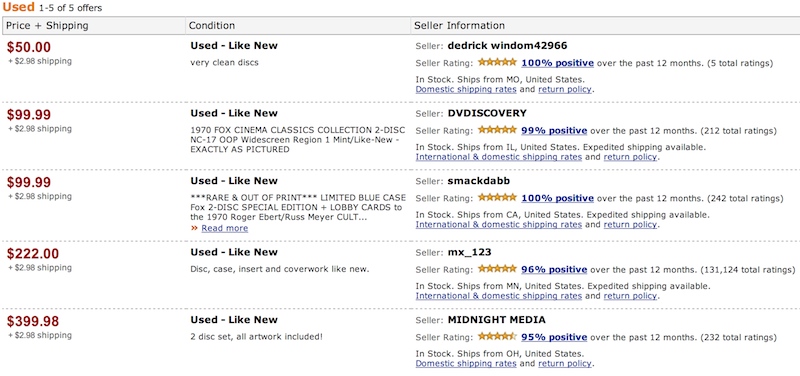
Daily Grab 117: Tea and Rain
I've chosen two stills from Yasujiro Ozu's Floating Weeds, the 1959 remake of one of the master's greatest silent films. One of the below was used in the piece I wrote about Roger Ebert earlier today.
My love of Ozu's work began thanks to his commentary on Criterion's DVD edition of the movie and his Great Movies article. Both frames below come from Masters of Cinema's recent Blu-ray release.
From Roger Ebert's touching, evocative, and nuanced examination of this Great Movie:
For me, Floating Weeds (1959) is like a familiar piece of music that I can turn to for reassurance and consolation. It is so atmospheric--so evocative of a quiet fishing village during a hot and muggy summer--that it envelops me. Its characters are like neighbors. It isn't a sad story; the central character is an actor with a healthy ego, who has tried to arrange his life according to his own liking and finds to his amazement that other people have wills of their own. He is funny, wrong-headed and finally touching.
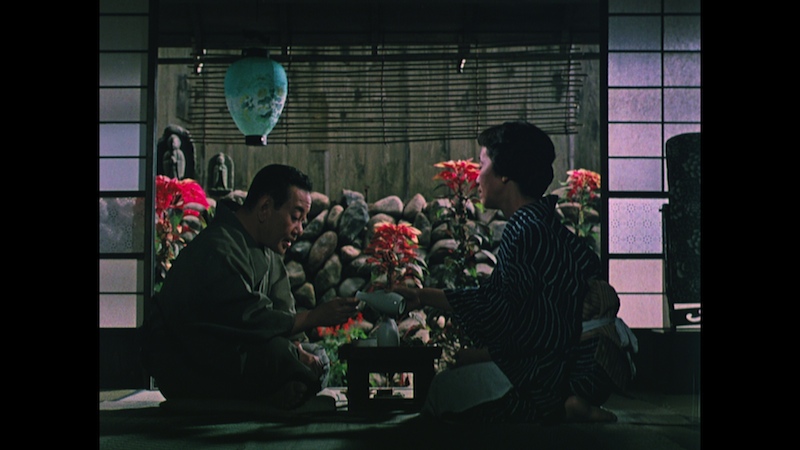
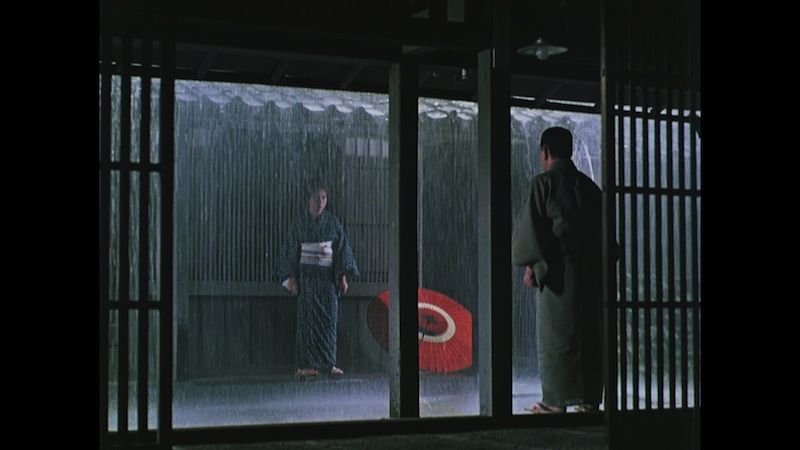
Roger Ebert: 1942-2013
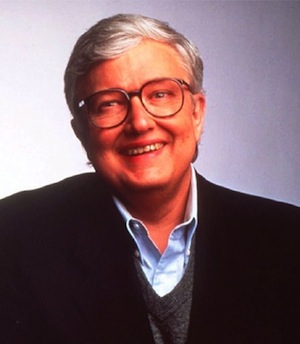 After commenting briefly on his "leave of presence" just two days ago, Roger Ebert is gone.
After commenting briefly on his "leave of presence" just two days ago, Roger Ebert is gone.
One of my bits of work for the day was to compose something a bit more substantive about just how much Roger's work has meant to me for most of my life. I didn't think that I would find myself composing it under these circumstances. You always want to think that there is more time.
The candor of his last column sounded hopeful, but there was an undercurrent of a General putting on his boots to charge toward the final battle with the vigor he had left.
I had always wanted to meet Roger, whether by attending his Overlooked Film Festival, or somewhere else. I don't feel that I missed out, or that I regret not making a concerted effort to see him though. I knew him from his appearing on my TV in the same way I knew other childhood heroes, from Mr. Rogers to Jim Henson. I knew his spirit and passion from the ink he spilled on the page, whether paper or digital. What Ebert managed to sculpt in a combination of the written word and televised discussion completely transformed the notion of the acceptable forms that film criticism could take.
Roger Ebert and "A Leave of Presence"
I've admired Roger Ebert and Gene Siskel since elementary school. Seeing their review show on TV was one of the earliest and most foundational influences on my becoming the fan, student, and critic of the moving image that I am today. I'm sad to hear that a form of cancer has returned and as a result, Roger Ebert is dialing some things back:
Typically, I write over 200 reviews a year for the Sun-Times that are carried by Universal Press Syndicate in some 200 newspapers. Last year, I wrote the most of my career, including 306 movie reviews, a blog post or two a week, and assorted other articles. I must slow down now, which is why I'm taking what I like to call "a leave of presence."What in the world is a leave of presence? It means I am not going away. My intent is to continue to write selected reviews but to leave the rest to a talented team of writers handpicked and greatly admired by me. What's more, I'll be able at last to do what I've always fantasized about doing: reviewing only the movies I want to review.
At the same time, I am re-launching the new and improved Rogerebert.com and taking ownership of the site under a separate entity, Ebert Digital, run by me, my beloved wife, Chaz, and our brilliant friend, Josh Golden of Table XI. Stepping away from the day-to-day grind will enable me to continue as a film critic for the Chicago Sun-Times, and roll out other projects under the Ebert brand in the coming year.
You should read the whole piece.
As much of a change is signaled by his pulling back from the frequency and quantity of reviews that this represent, I'm glad to know that his time will be focused on the work he wants to be doing and reviewing only the movies he wants to review. I'll be reading not only what he makes the time for, but the work of those he hand-picks as well. Roger Ebert has always had good taste.
I need to sleep on some further thoughts I have about Roger before I set to pounding them out into words.
RogerEbert.com relaunches on April 9.
48fps is Charlie Chaplin's Fault (Sort Of)

Is it me, or do we forget innumerable progressive achievements throughout the history of cinema?
This is especially the case with the discussion of High Frame Rate photography and exhibition. Most of the chatter has centered around the pending release of The Hobbit at 48 frames per second, a rate that doubles the standard accepted for over 75 years. Some would say this is a cheap gimmick, or even a nefarious plot of some sort by the studios and billionaire directors and the Illuminati and Xenu and Stalin.
Let's back up and take a cleaner, less sensational look at things, Spider-friends.
What we consider to be "cinema" runs at 24 still image frames per second in front of our eyes. In the days of silent films, they ran at 16-18 frames per second. The difference in the number of frames is what makes our association with what "old" movies look like at a glance. The jumpy, jerky look of silents is unmistakeable. To some, it causes instant revulsion, as it connotes something that they refuse to watch, whether for dissimilarity to what they're accustomed or out of perceived inferiority. If only those many knew what they were missing out on, but that's another column for another day.
The more frames, the smoother the image, and the more pleasing to the eye. The mandatory move to 24 frames was due to the soundtrack for sound films needing those additional frames to properly sync. Instead of 60 feet of film going through the projector per second, 90 feet hurtled through, assaulting early 20th century eyes with a more fluid, luxurious picture than they thought possible. They probably would have done more frames per second, but they ran the risk of the projectors shredding the film. The use of 30 frames per second was right at the bleeding edge in the early days, but it would only come into mainstream use later, predominantly in videotape-based photography (think of BBC teledramas like I, Claudius, or modern Asian soap operas).
The 24 fps flicker effect is what we came to associate with the cinematic aesthetic. It was a warm balance between the real world and the still life of individual frames, but not too far in either direction.
The problem of celluloid tearing itself apart in the projector assembly is no longer a problem in the digital age, where most film exhibition is (lamentably) done off of hard drives. The elimination of this limitation led tech nerd, pro-3D directors like James Cameron, Peter Jackson, and various others to decree a push toward 48, 60, and even 120 frames per second cinema.
Even before these directors and digital, brilliant minds like Roger Ebert and Douglas Trumbull advocated exhibition processes like Maxivision 48 (Ebert) and ShowScan (Trumbull). Processes like these required loads of equipment upgrades in principal photography and in the exhibition world, and from what I've read, it would appear that the death of their widespread adoption was that neither end of the business wanted to move first and risk that the other end wouldn't come through. Both processes benefitted from radically improved clarity and as a result, focal depth. Your eyes had less work to do when they were supplied with all of that additional visual stimuli, and the work of a master cinematographer could simply wash over you.
Fast forwarding back to the recent past, the CinemaCon announcements from Cameron, Jackson, and company a couple of years ago riled many cinema fans who speculated that they were somehow shoving something down our throats. What could be characterized as innovative, pioneering filmmakers touting bold new experiments was instead met with suspicion and the sharpening of pitchforks.
Many lashed out at the "profiteering millionaires" in controlled bursts when feature articles or interviews mentioning the topic would pop up. The simmering rolled to a full boil following the screening of 48fps footage from The Hobbit at CinemaCon three months ago.
I was part of the flood of those reactions, and at the time, I had mixed feelings about the whole thing. I remain leaning toward the hopeful side, even with the announcement that tomorrow's Hobbit presentation will only feature footage in 24fps.
I'm not bothered at all by that decision. My educated guess is that they don't want to make the mistake once again of showing the unfinished, unrepresentative version of a very different cinematic aesthetic to a room full of people predisposed toward hypercriticism. I think that is very wise. The biggest issues I had with the CinemaCon demo was that the virtually finished (color corrected, filtered, etc), fuller sequences that played like scenes actually worked great for me. The bits that played like traditional sizzle reel stuff played against the benefits of the tech they were showing off. It's crazy not to show off a new technological product in the properly curated, finished-quality form for which it is designed. This is the same as composing a movie for 3D if it is to be released in 3D, from boarding to shooting and editing. This is why movies like Hugo and Prometheus look so outstanding in 3D: the right work was done, soup to nuts.
I look forward to Warner Bros hopefully doing something like those Avatar Days that Fox did, where people could get their eyes wet with Avatar's overwhelming (in the good way) 3D. The portions of that Hobbit reel that worked really left the room speechless. I can only imagine what the right 20 minutes would do to the skeptical, including an undetermined quantity of holdout theatre owners.
Since that morning in April, I haven't had the opportunity to watch any more HFR content, but I have thought a great deal about it.
Any time I've watched a movie or TV show, I notice motion blur and strobing more actively than I did previously. The effect of eye strain when watching both 2D and 3D content has become infinitely more pronounced. In recent interviews I've conducted, I've made a point to ask visual artists their thoughts about HFR. I find that most of their opinions are optimistic and curious. Pietro Scalia (editor on both Prometheus and The Amazing Spider-Man) sounded very eager to play with it when we spoke in Aruba a couple of weeks ago. He saw it as a new set of tools to play with, not a mandate.
The audience, it would appear, is much more anxious and unsettled by the idea of change than the people whose livelihoods it immediately affects. I may be overreaching there, but from the limited sampling I've done, the artists want to jump in that sandbox.
There's something to be said for trying new things in the cinema. In the past, doing so has brought us sound and color, along with countless other advances in the photographic process. We've gotten marvelous things like deep focus, large-format exposure (70mm, 4K), and visual effects.
Those special effects have gone from miniatures and matte paintings to in-camera optical tricks to computer-generated composite wizardry, and all sorts of things in-between, including stereographic 3D. It is not universally a good thing, but like all visual effects, it's all in the application.
It took me until last week to realize that the sorts of things we find ourselves thinking are brand-new bastardizations or perversions of the art have been around for decades.

While combing through Criterion's recent Blu-ray release of Chaplin's The Gold Rush, I realized that, in a way, the push toward HFR and upconverting to the higher standard started 70 years ago. Believe it or not, Chaplin made a decision tantamount to George Lucas' discarding of the original theatrical editions of the original Star Wars trilogy.
The Gold Rush was first released in 1925. It was an enormous hit, and made tons of money. By the time he released The Great Dictator in 1940, even Chaplin, the holdout, had embraced the onset of talkies. The notion of repertory screenings of movies after their original run was a new idea gaining traction, but in 1940, no one would dare release a silent film. Chaplin therefore recut Gold Rush, removing all of the title cards and adding narration and dialogue that were performed as if he were telling the story and there just happened to be images to go along with it. It's the style that the Fractured Fairy Tales cartoons ripped off wholesale (and quite successfully).
The addition of sound required the film to be sped up to 90 feet or 24 frames per second. When all was said and done, the movie was 16 minutes longer, featured various alternate takes or reshoots entirely, post-converted to 24fps, and added a completely different mood to the picture as part of the added soundtrack. From that point, and for the rest of his life, Chaplin would consider the 1942 version his definitive cut.
So naturally, he destroyed every copy of the 1925 version that he had or could find. He "pulled a George Lucas" before there was a George Lucas to accuse of that.
The story of how the 1925 version was miraculously salvaged and restored is told in featurettes on the Blu-ray, but suffice to say that from 1942 until 1993, no one could have seen the original classic film. When the restoration was completed in 1993, Chaplin's children made it clear that they only allowed the reconstructed version to be completed as a curiosity for the sake of historical record.
I know I'm not alone when I say that I'm very, very glad that they did the right thing. I prefer the 1942 version, and it's the one that I rewatch most often, but I don't know if that's because I objectively prefer it...or because it's the one that I always knew until the 2003 DVD allowed me to see both versions. For new viewers, I would unquestionably urge them to see the '25 and then the '42.
When I contemplated '25 vs. '42 the other day, I think I would have still preferred the one that could justifiably be called a post-converted, re-imagined bastardization.
I wonder how the final products of refined HFR cinema will fare with the audience, both the natively-shot and possible "up-conversions". I wonder if we'll see the same effect that happened with Gold Rush. I wonder if filmmakers will adopt a mixed approach, using an adapted "Variable Frame Rate" methodology (ok, Tony Scott has been doing that for years).
I'm just glad that we're still trying new things, and that more amazing advances could still be on the horizon.
